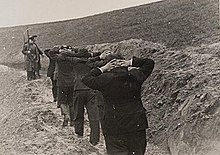Intelligenzaktion Pommern
| Intelligenzaktion Pommern | |
|---|---|
| Part of Anti-slavism |
The Intelligenzaktion Pommern
On the direct orders from
Background
After the
Organized action aimed at exterminating the Polish population of the region, however, began only after the end of the September campaign, with the Intelligenzaktion Pommern, a part of an overall
Prepared list of targets

Even before the Nazi invasion of Poland, German police and
Between the fall of 1939 and spring of 1940, in the Intelligenzaktion and other actions, the Nazis killed around 100,000 Polish intellectuals and other prominent citizens, 61,000 of whom came from
Method of realisation
The action was realised by
Locations

Most executions of this regional action took place in forests near
German SS units
Those who participated in the mass murder in Piaśnica included:
- Einsatzkommando 16, under command of head Danzig Gestapo, Rudolf Tröger
- special unit of the SS – 36 Regiment SS Wachsturmbann ˝Eimann˝ under command of Kurt Eimann
- members of local Selbstschutz
- Mass murder in Szpęgawski Forest
- special unit of the SS – 36 Regiment SS Wachsturmbann ˝Eimann˝ under command of Kurt Eimann
- members of Selbstschutz from Starogard Gdański under command of SS-Unterscharführer Paul Drews
- 12 members of SS Heimwehr Danzig under command of SS-Obersturmführer Wilhelm Fast
- Mass murder in Mniszek
- special unit of the SS – 36 Regiment SS Wachsturmbann ˝Eimann˝, under command of Kurt Eimann
- members of local Selbstschutz
See also
- Sonderaktion Krakau
- German AB Action operation in Poland
- Massacre of Lwów professors
Notes and references
- ^ a b Moor-Jankowski, Jan. "Holocaust of Non-Jewish Poles During WWII" by Project InPosterum (in) WarsawUprising.com. Courtesy of Polish American Congress, Washington. Retrieved 14 November 2014.
- ^ Ignatowicz, Aneta (2009). Tajna oświata i wychowanie w okupowanej Warszawie (in Polish). Warsaw: Fundacja Warszawa Walczy 1939–1945. p. 10.
Intelligenzaktion Pommern – operacja przeprowadzona na Pomorzu, w której zamordowano 23 tysiące Polaków.
- ^ Tadeusz Bujnicki, Anna Skoczek (2006), Literatura współczesna: (1939–1956), page 106.
- ^ Stefan Sutkowski (2001), The history of music in Poland: The Contemporary Era. 1939–1974. Vol. 7, page 37: "...some 183 professors of the Jagiellonian University and the Academy of Mining and Foundry in Cracow were arrested, with similar actions undertaken in Pomerania and Silesia (known as the Intelligenzaktion Pommern und Schlesien)" (Google Books).
- ISBN 978-3-88680-859-5.
- ^ ISBN 978-83-7629-063-8. Archived from the original(PDF) on 29 November 2014. Retrieved 17 November 2014.
Oblicza się, że akcja "Inteligencja" pochłonęła ponad 100 tys. ofiar. Translation: It is estimated that Intelligenzaktion took the lives of 100,000 Poles.[p. 8, or 10 in PDF]
- ^ ISBN 978-3-406-54966-3.
Tausende von psychisch kranken Patienten aus Anstalten in Pommern, Ostpreussen und dem Gebiet um Posen im Warthegau wurden bald nach dem deutschen Angriff auf Polen eliminiert.[p.40, note 34] (Google Books)
- ISBN 978-3-534-18096-7.
- ISBN 978-3-534-18096-7.
- ^ Prof. Dietrich Eichholtz (2004), »Generalplan Ost« zur Versklavung osteuropäischer Völker. Archived 24 June 2008 at the Wayback Machine PDF file, direct download 74.5 KB.
- ^ Jerzy Lukowski, Hubert Zawadzki, A concise history of Poland, Cambridge concise histories, Concise Histories Series, Cambridge University Press, 2001, pg. 228, [1]
- ^ Jochen Böhler, "Zbrodnie Wehrmachtu w Polsce" (Warcrimes of Wehrmacht in Poland), Wydawnictwo Znak, Kraków, 2009, pg 183–192
- ISBN 978-3-8012-5029-4– Polish translation Dieter Schenk "Albert Forster gdański namiestnik Hitlera. Zbrodnie hitlerowskie w Gdańsku i Prusach Zachodnich" Gdańsk 2002ISBN 978-83-86181-83-4
- ^ a b c d e Elżbieta Grot, "Ludobójstwo w Piaśnicy z uwzględnieniem losów mieszkańców powiatu wejherowskiego." Genocide in Piaśnica with a discussion of the fate of the inhabitants of Wejherow county", Public Library of Wejherowo,[2] Archived 9 February 2010 at the Wayback Machine
- ISBN 978-83-88822-03-2.
- ISBN 978-83-223-2369-4.
- ISBN 978-83-11-11588-0.
- ^ Tadeusz Nasierowski, Zagłada osób z zaburzeniami psychicznymi w okupowanej Polsce. Początek ludobójstwa, wydawnictwo Neriton, Warszawa 2008.
- ^ [3] Archived 24 March 2009 at the Wayback Machine history of Chojnice in Polish
- "Mass murder in Piaśnica in 1939" article (in Polish)
Bibliography
- Elżbieta Grot, Ludobójstwo w Piaśnicy z uwzględnieniem losów mieszkańców powiatu wejherowskiego (Genocide in Piaśnica with addition of the fate of the inhabitants of Wejherowo county). Public Library of Wejherowo. "Biblioteka Publiczna Gminy Wejherowo im. Aleksandra Labudy w Bolszewie". Bpgw.org.pl. 10 February 2009. Archived from the original on 9 February 2010. Retrieved 30 June 2010.
- Maria Wardzyńska, Był rok 1939 Operacja niemieckiej policji bezpieczeństwa w Polsce. Intelligenzaktion, IPN ISBN 978-83-7629-063-8
- Tadeusz Piotrowski (1998). Poland's Holocaust: Ethnic Strife, Collaboration with Occupying Forces and Genocide in the Second Republic, 1918–1947. McFarland. p. 25. ISBN 978-0-7864-0371-4.
- Maria Wardzyńska: Intelligenzaktion" na Warmii, Mazurach oraz Północnym Mazowszu. Główna Komisja Ścigania Zbrodni Przeciwko Narodowi Polskiemu. Biuletyn Instytutu Pamięci Narodowej nr. 12/1, 2003/2004, ss. 38–42. "W oparciu o Dokumenty Google". Retrieved 30 June 2010.
- Andrzej Szcześniak: Generalplan Ost. Plan Zagłady Słowian. Radom: Polskie Wydawnictwo Encyklopedyczne, 2001, ISBN 978-83-88822-03-2.
- Dieter Schenk "Hitlers Mann in Danzig Gauleiter Forster und die NS-Verbrechen in Danzig-Westpreußen", J. H. W. Dietz Nachf. Verlag, Bonn 2000, ISBN 978-3-8012-5029-4
- Meier, Anna "Die Intelligenzaktion: Die Vernichtung der polnischen Oberschicht im Gau Danzig-Westpreußen" ISBN 978-3-639-04721-9
